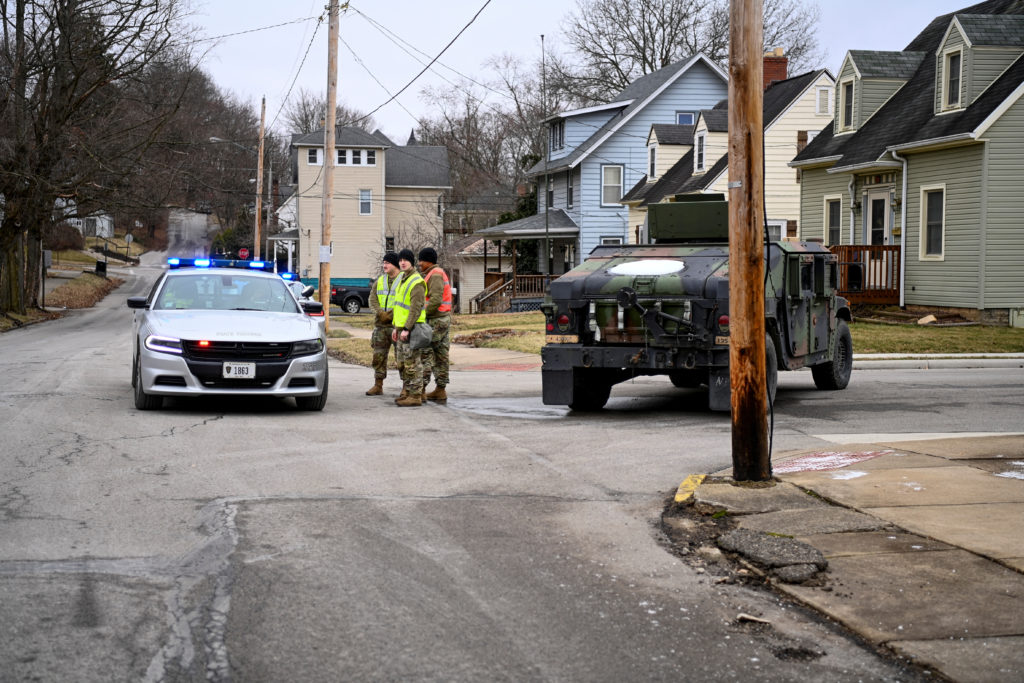Ohio Train Derailment: The Persistence Of Toxic Chemicals In Buildings

Table of Contents
The Nature of the Released Chemicals and Their Persistence
The Ohio train derailment released a cocktail of hazardous substances, most notably vinyl chloride, butyl acrylate, and ethylene glycol monobutyl ether. These chemicals exhibit varying degrees of persistence, meaning they don't readily break down in the environment and can remain for extended periods, posing a significant long-term threat. Understanding their properties is crucial to assessing the risk.
-
Vinyl chloride: This volatile organic compound is known for its carcinogenic properties. Its volatility means it can easily evaporate into the air, but it can also linger in porous materials like carpets, drywall, and insulation, releasing slowly over time.
-
Butyl acrylate: This chemical is less volatile than vinyl chloride but can still be absorbed into building materials, potentially leaching out slowly. It's also known to cause respiratory irritation and other health problems.
-
Ethylene glycol monobutyl ether: This chemical is also concerning due to its potential for long-term health effects, even at low exposure levels.
The concept of bioaccumulation further complicates the issue. This refers to the process where chemicals accumulate in living organisms over time, potentially magnifying their concentration as they move up the food chain. The long-term health effects of exposure to these chemicals, even at low levels, underscore the urgency of addressing building contamination.
Potential Pathways of Contamination in Buildings
The released chemicals could have entered buildings through several pathways, creating a complex contamination scenario:
-
Airborne contamination: The initial release and subsequent controlled burn of vinyl chloride released a significant plume of toxic chemicals into the air, potentially leading to airborne deposition within buildings.
-
Surface contamination: Rain and settling could have deposited chemicals onto building exteriors and surfaces, potentially leading to further indoor contamination.
-
Water contamination: Soil leaching from contaminated land can contaminate local water supplies, leading to contamination through drinking water and household use.
-
Absorption into building materials: Chemicals could have been absorbed directly into porous building materials such as carpets, drywall, insulation, and even wood, potentially releasing slowly over time, impacting indoor air quality (IAQ). This slow release presents a significant challenge for long-term remediation efforts.
Health Risks Associated with Long-Term Exposure
Long-term exposure to even low levels of these chemicals presents several serious health risks to residents, particularly vulnerable populations such as children and the elderly. The potential consequences include:
-
Respiratory problems: Increased risk of asthma, bronchitis, and other respiratory illnesses.
-
Cancer risk: Several of the released chemicals are known or suspected carcinogens, increasing the risk of various cancers over time.
-
Neurological damage: Exposure can lead to neurological damage and developmental problems, particularly impacting children's brain development.
-
Reproductive health issues: Studies have linked exposure to some of these chemicals to reproductive health problems.
The need for extensive long-term health monitoring of East Palestine residents is paramount to understanding the full scope of the health consequences.
Cleanup and Remediation Efforts
Cleaning up building contamination after the Ohio train derailment poses significant challenges. The process requires careful assessment and remediation strategies tailored to the specific type and level of contamination found in each building. Current efforts need to be enhanced by:
-
Comprehensive air and water testing: Thorough testing is needed to identify the extent of contamination in buildings and ensure the safety of residents.
-
Building decontamination: This may involve various techniques, depending on the type of contamination, from simple cleaning to more complex methods like removing and replacing contaminated materials.
-
Soil remediation: Contaminated soil around buildings needs to be addressed to prevent further leaching and contamination.
-
Community involvement: Transparent communication and community involvement are essential to ensure effective cleanup and address residents' concerns. The role of the EPA and other agencies in overseeing and coordinating these efforts is critical.
Conclusion
The Ohio train derailment underscores the critical need for comprehensive and ongoing strategies to address the long-term risks associated with toxic chemical contamination in buildings. The persistence of these chemicals in building materials presents significant health risks to residents, demanding thorough testing, effective remediation, and long-term health monitoring. The complexities of identifying and removing contamination highlight the need for a multi-pronged approach involving government agencies, environmental experts, and the affected community.
Call to Action: Understanding the persistent nature of toxic chemicals released from the Ohio train derailment is crucial for protecting public health. Demand comprehensive testing and transparent, effective cleanup efforts to ensure the safety and well-being of the East Palestine community. Learn more about the long-term health effects of exposure to these chemicals and advocate for stricter regulations to prevent similar incidents in the future. Stay informed about the ongoing Ohio train derailment cleanup and its impact on building safety.

Featured Posts
-
 Investigating The Spread Of A Dangerous Fungus In A Changing Climate
May 25, 2025
Investigating The Spread Of A Dangerous Fungus In A Changing Climate
May 25, 2025 -
 Heineken Tops Revenue Expectations Reaffirms Outlook Despite Tariffs
May 25, 2025
Heineken Tops Revenue Expectations Reaffirms Outlook Despite Tariffs
May 25, 2025 -
 A Relaxing Escape To The Country Tips For A Stress Free Transition
May 25, 2025
A Relaxing Escape To The Country Tips For A Stress Free Transition
May 25, 2025 -
 Onrust Op Amerikaanse Beurs Maar Aex Stijgt Analyse Van De Markten
May 25, 2025
Onrust Op Amerikaanse Beurs Maar Aex Stijgt Analyse Van De Markten
May 25, 2025 -
 Andrew Forrest And Rio Tinto Clash Over Pilbaras Future A Critical Examination
May 25, 2025
Andrew Forrest And Rio Tinto Clash Over Pilbaras Future A Critical Examination
May 25, 2025
Latest Posts
-
 Florentino Perez El Real Madrid De Sus Primeros Anos
May 25, 2025
Florentino Perez El Real Madrid De Sus Primeros Anos
May 25, 2025 -
 Canli Izle Atletico Madrid Barcelona Maci Fanatik Gazetesi Ile
May 25, 2025
Canli Izle Atletico Madrid Barcelona Maci Fanatik Gazetesi Ile
May 25, 2025 -
 Atletico Madrid Barcelona Maci Canli Skor Fanatik Ten Dakika Dakika Detaylar
May 25, 2025
Atletico Madrid Barcelona Maci Canli Skor Fanatik Ten Dakika Dakika Detaylar
May 25, 2025 -
 Barcelona Atletico Madrid Maci Canli Yayin Anlik Sonuclar Ve Goller
May 25, 2025
Barcelona Atletico Madrid Maci Canli Yayin Anlik Sonuclar Ve Goller
May 25, 2025 -
 Atletico Madrid Barcelona Maci Canli Izle Fanatik Gazetesi Nden Canli Anlatim
May 25, 2025
Atletico Madrid Barcelona Maci Canli Izle Fanatik Gazetesi Nden Canli Anlatim
May 25, 2025
